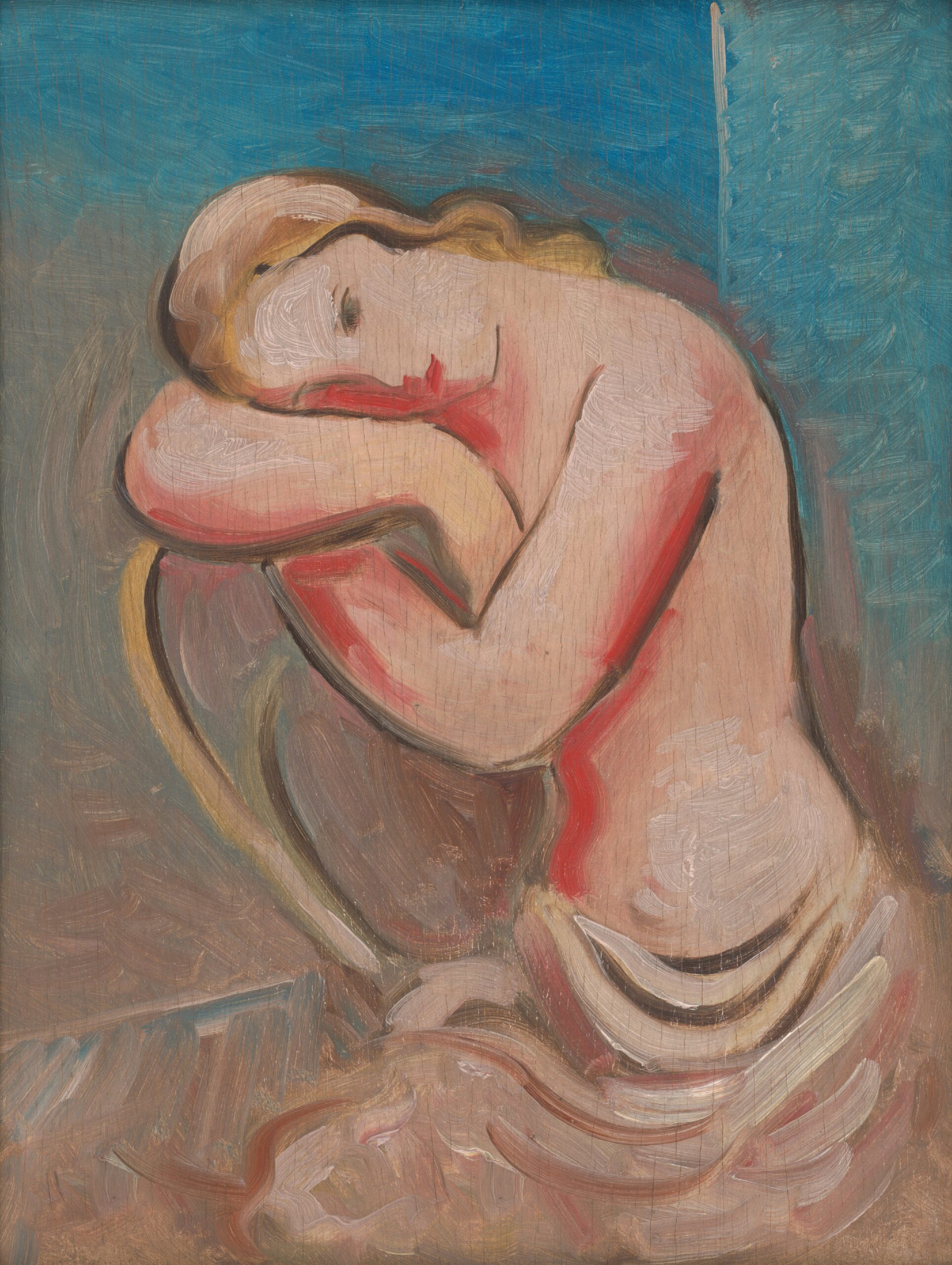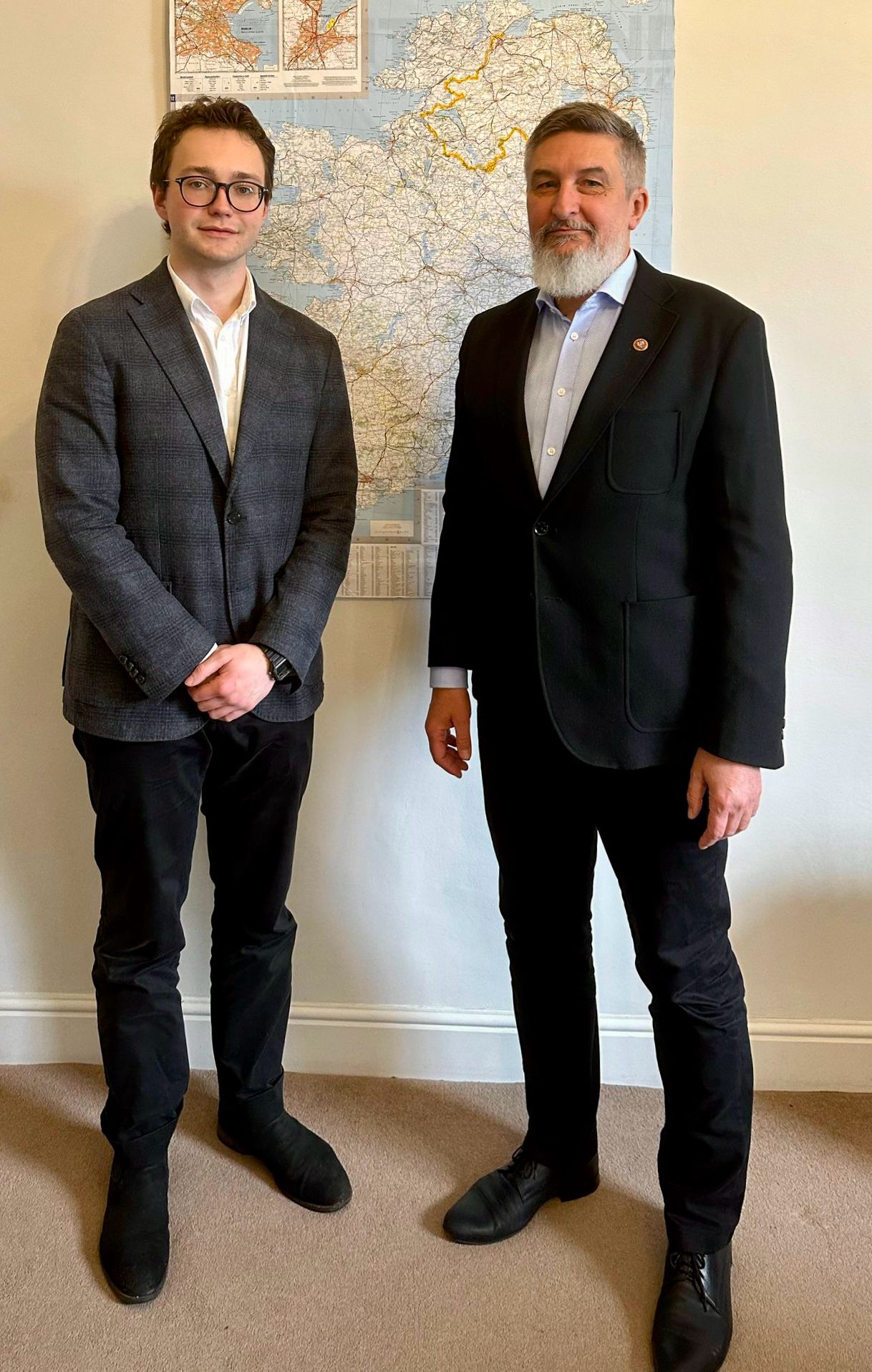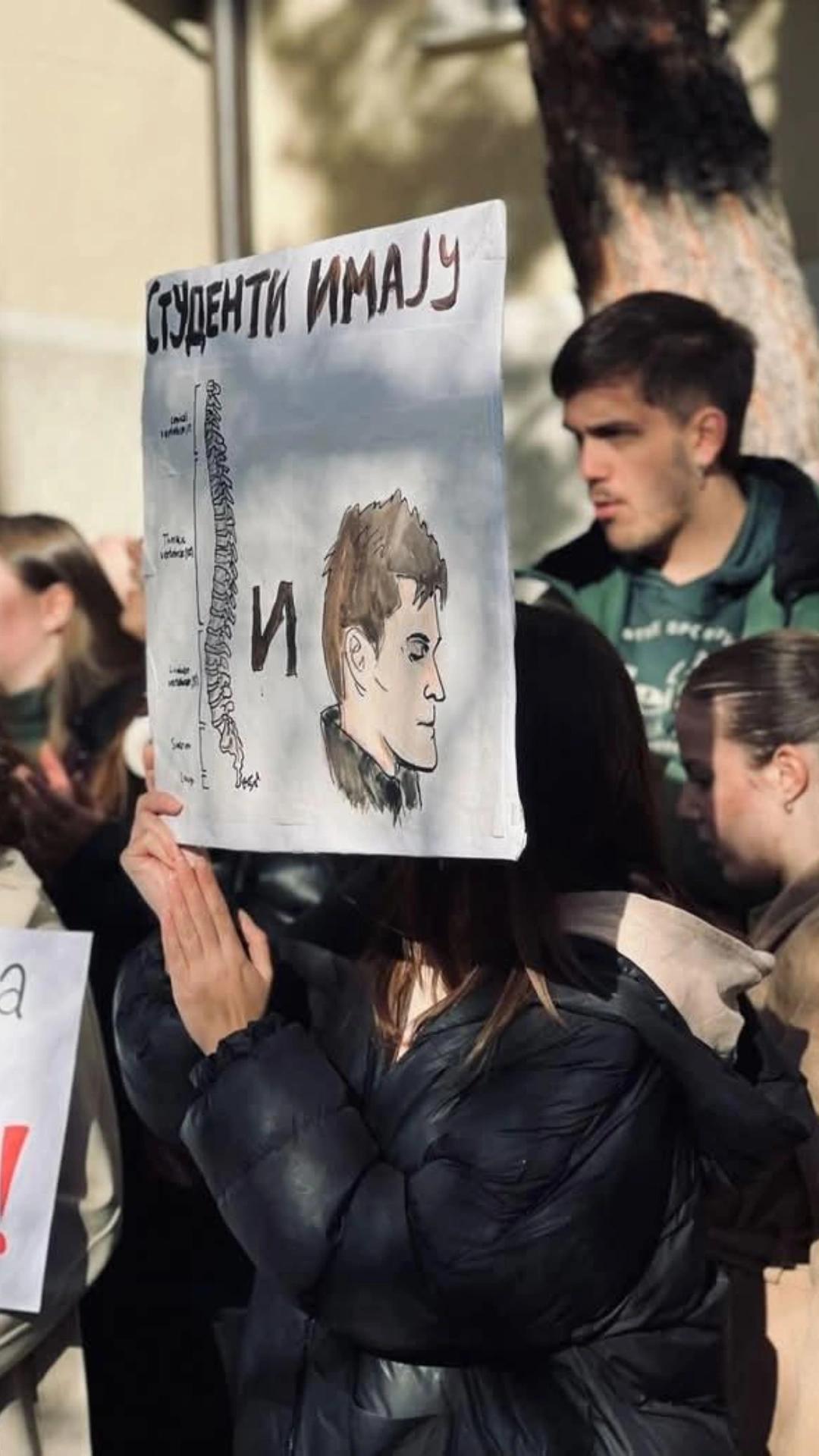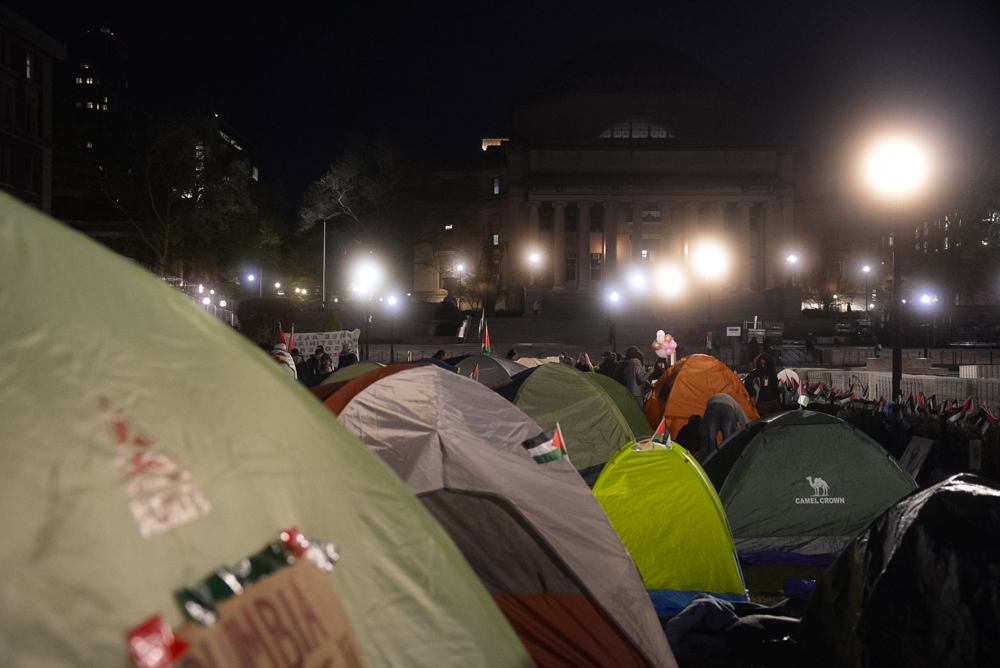
Amidst the comforting old-book smell, the glass encasement smack-dab in the middle of the Long Room immediately catches your eye. Upon closer inspection, your eyes move towards a bright-pastel illustration of a satirical and semi-fictional rendition of the famous W.B Yeats by artist Annie West. Yeats is sprawled out on a maroon chaise with a clutter of papers about and a seemingly annoyed Maud Gonne lingering in the background. This witty and poignant representation of the “what if” of these two Irish historical figures, that is, the what if Maud had “said yes” to Yeats’ numerous marriage proposals, is just the beginning of your journey throughout the Old Library’s newest exhibition.
Annie West’s “If Maud Gonne had said Yes,” Yeats in Love is just one of the pieces featured in the Old Library’s new exhibition “Zealous Mercurial Dreams Were About to Be Realised: New Treasures of the Old Library.” The showcase opened on January 30 of this year and has captured the hearts of the Trinity community ever since. The exhibition continues until May 30, in lieu, with its regenerative spirit and excitement of the coming of spring. I had the honour of talking to Laura Shanahan, Head of Research Collections at the Library of Trinity College Dublin, upon my visit to the exhibition, where I witnessed the grandeur of this literary project firsthand. As the Old Library continues to undergo literary restoration, this exhibition has breathed new life into the Long Room. With an emphasis on not only our past itself, but also on how it shapes and seeps into our future, “Zealous Mercurial Dreams Were About to Be Realised” is a beautiful culmination of an enduring and provocative spirit.
This exhibition looks to the past of prolific and impactful Irish writers such as Bram Stoker, Samuel Beckett, and Christy Nolan. But the experience only begins there. Works by modern literary greats like Eiléan Ní Chuilleanáin, Jessica Traynor, and John Banville pull the expertise of the past into the reality of our present. The experience highlights additions to the Old Library from the past five years, but the story they curate is far more expansive. It represents the story of the Old Library and Trinity College itself–a formative experience with ups and downs, the complexities of life in their raw form, but the ultimate progression of possibilities coming to fruition. Even before reaching the inside of the Long Room, Shanahan immediately emphasised the importance of the work of archivists today and the ethical implications surrounding their contributions. “We live the way we want to be, rather than live the way things are presented to us. The archivists within the sector look at the code of practice, which talks about the ethical principles of collecting,” explains Shanahan. The commitment to ethical preservation and restoration shines through the exhibit itself. “What you have here is equity and equality represented across all of society. And that’s the way that we should behave when we’re thinking about documentary records and preserving them for the future,” she concludes. The archivist explains that this exhibit is directly aligned with those principles of equity and access for all. The individual pieces of the exhibit, which we soon dove into, shed light onto the transformative experience of a welcoming and equitable space.
The first intriguing piece of this exhibit is “Camels weep, did you know?” a part of the Beckett Janvier Collection. The collection recently acquired this miniscule notecard sent from Samuel Beckett to his two translators, Ludovic Janvier and Agnès Vaquin-Janvier in November of 1969. Shanahan explains that this notecard is “so typically Beckett in the sense that there’s very little there.” Yet even with minimal language, the notecard strikes the viewer with immense emotion. The notecard is translated from French into English, and she feels that although there are very few words, each translated sentence has significant depth. One of her favourite phrases written on the piece is, “one can’t have everything.” Here, Beckett is referencing his current hiding in Tunisia to avoid being awarded the Nobel Prize for Literature, which was later famously referred to as a “catastrophe” for Beckett by his wife. Beckett yearned to remain behind closed doors, sharpening his creativity away from the distraction of media and attention. He closes the note with, “Camels weep, did you know?” Shanahan feels most readers are in awe of the seeming absurdity Beckett culminates this note with. “You could think of it as him saying, ignore the kind of human capacity for creativity. Nature is just so incredibly wonderful and everything’s designed in this biological way to perform its function if we pay attention to it,” exclaims the archivist.
Shanahan next led me to the informative video about Christy Nolan, his familial experience, and his literary genius. The Christy Nolan Archive highlights much of Nolan’s life, including photographs of Christy Nolan at work in his family kitchen and typescripts of “I Learn to Bow” and “I Peer Through Ugliness” in this exhibit. Nolan was awarded the Whitbread Book of the Year Award, the Medal of Excellence by the UN Society of Writers, and Irish Person of the Year in 1988. Beyond that, he published countless poems, plays, and novels starting at the early age of eleven. With the support of his mother, his occupation therapist, and his entire family, Nolan forged a path to share his passion of writing with the whole world, although he suffered from cerebral palsy with severe quadriplegia. His disability often forced him into a marginalised experience, especially at a time when an open dialogue about the realities of disabilities was entirely dismissed. For this archive, which is generously supported by the Nolan family, Shannahan explains that it is extremely important that what appears first is Nolan’s “exceptional talent and capability for writing.” His strength did not end with his raw literary talent. “What sits over the top of that is the absolute awe-inspiring capability he had to persevere,” says Shanahan. This archive highlights not only the exceptional work of Nolan, but also the importance of “focusing back in on disabled people’s capacity to be inspirational from a creative point of view, from what they’ve achieved in life as individuals, not as a subsection of society,” reminds Shanahan. Shanahan explains the exhibition’s work with the Student Disability Service to host a creative essay competition was an exciting success and was pivotal in expanding the commitment to true inclusivity. Nolan’s Archive has allowed for the exhibition to push accessibility in academia and literature to the forefront. “It’s really important that each of us take the time out of our lives to kind of think around that in order to ensure that people can participate and can be involved,” Shanahan concludes.
Shanahan explains that the curating team deliberately wanted to do something very colourful with the exhibition. “What’s within the volumes is obviously where the inspiration comes from,” she says. The cover artwork for this exhibition was reproduced from a private press edition of Yeats poem, When You Were Old, titled Woodcut by Elide Piras. Matching this artwork with Christine Owen’s piece, “Zealous Mercurial Were About to Be Realised” represents the “world is your oyster” type of inspiration that hits you while exploring the Library’s collections, Shanahan shares.
So what does it take to put together an exhibition like this one? Quite a bit. The material shown in the exhibition has been acquired since when Covid started. Shanahan explains that the exhibit showcases only one or two items from each general collection. “The Beckett notecards have 100 letters and notecards in total. The John Bamble Archive dates back over four decades,” she says. This means the researchers sift through hundred archival boxes and digital files to curate the final exhibit. To complete a detailed analysis of these archives, Shanahan explains that it truly “takes a village when you’re doing something like this.” Whether it’s through academic partnerships, videographers, proofreaders, or communications colleagues, the establishment of this exhibition was anything but a one-person job. “The four or five months in the run-up to making this all happen is quite full on, but very much worthwhile,” concludes Shanahan.
The time and effort placed into the curation of this exhibition truly shines through as we conclude our walk around the various pieces. Jamie Murphy’s well-designed book collection of poetic and artistic responses to Johnathon Swift’s poem, “A Modest Proposal,” is yet another highlight of the exhibition. “I love the response people have had to this piece in particular,” says Shanahan. As a reflection back on Swift’s messages in “Modest Proposal,” this piece “really looks at how far society has changed since that time period,” Shanhan also explains. David O’Kane’s and Jessica Traynor’s work is paired in Murphy’s artistic revisioning. The collection of visual and written expressions of the transition from past to present, but the reality of injustices and struggles which still remain, is an imperative piece.
“Zealous Mercurial Dreams Were About to Be Realised” is not only about preserving our literary heritage. It’s about looking to that heritage to critically think about how we enter our future. “The intent of [of the exhibit] being so vivid and visually attractive is to draw you back into history and to remind you that history is not something that’s behind us, it’s something that we live with today,” says Shanahan. And as you walk through this exhibition, that feeling certainly clings to you. Each piece reflects on a critical part of not only our literary history, but also our very uniquely human experience. “We really are a living library…what this exhibition tries to showcase is some of the collecting the now, as well as looking back the way and saying: ‘How do we make sure we represent as many people as we can in these collections?’” Shanahan explains. The strength of the history present here provides beautiful inspiration for the humanness of literary experiences to come. “Zealous Mercurial Dreams Were About to Be Realised” is on display in the Long Room until May 20 and has many of the collections available to view online on TCD Library website.






